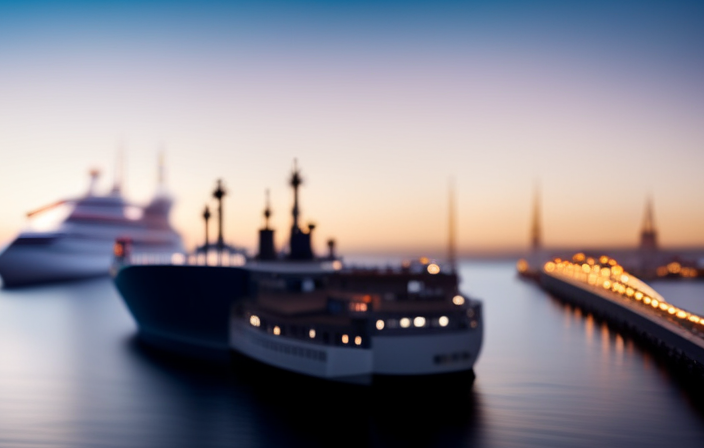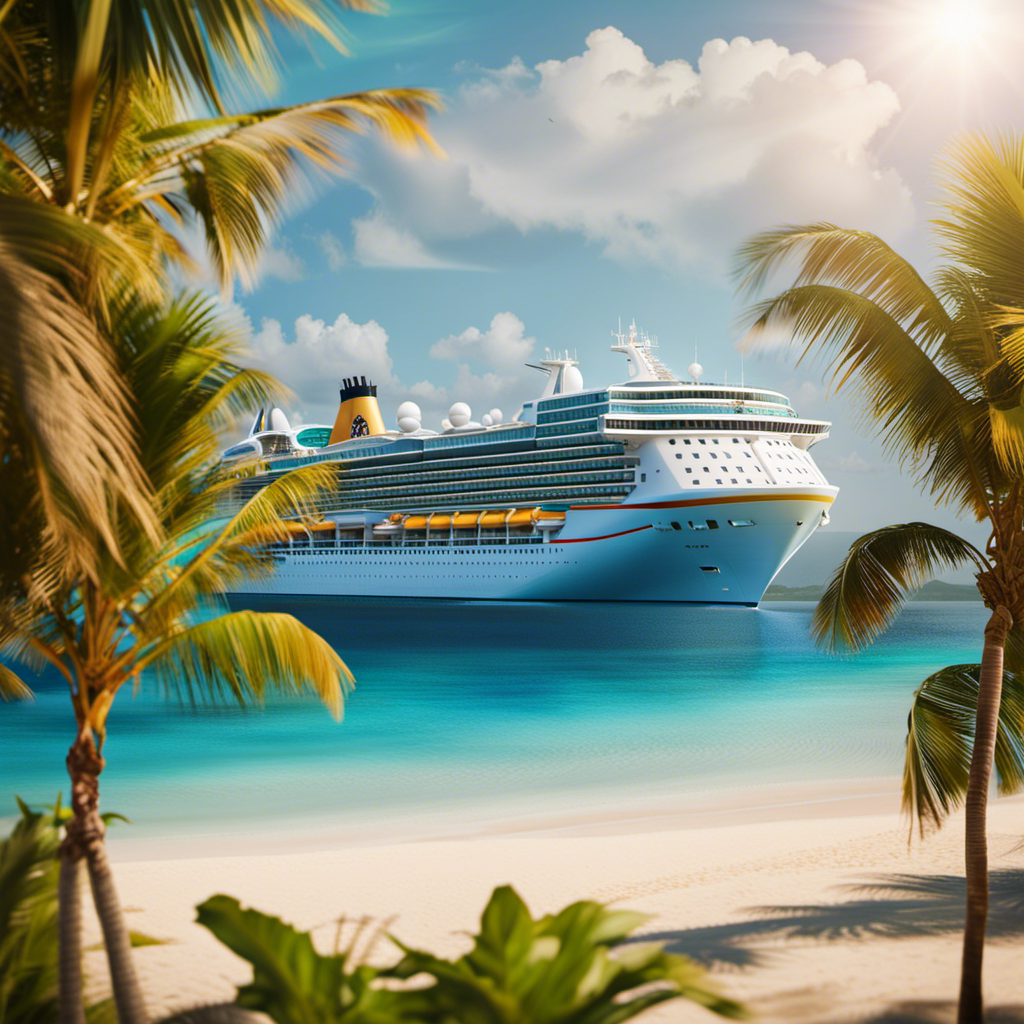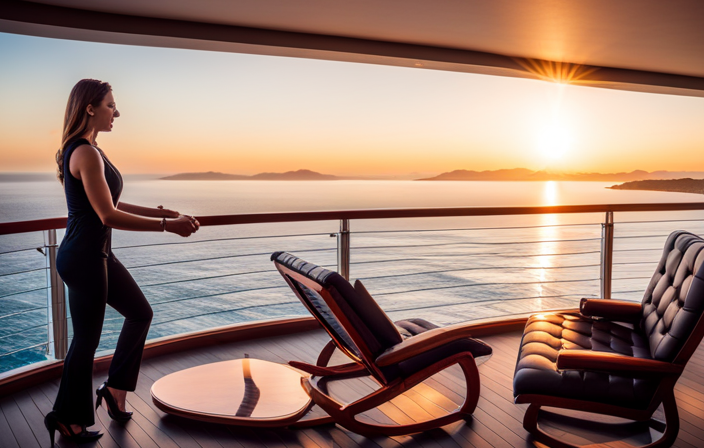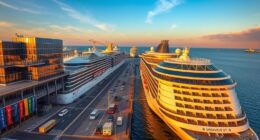Picture embarking on an incredible adventure aboard a luxurious cruise ship, feeling the breeze in your hair and the sun’s rays embracing your skin. For numerous individuals, this is the fulfillment of a long-held aspiration. Yet, have you ever paused to consider the economic implications of powering these immense vessels that carry us across the seas? I am prepared to explore the realm of fuel expenses for cruise ships and illuminate this fascinating subject for you.
In this article, we’ll explore the factors that impact fuel costs for cruise ships, from understanding the different types of fuel used to calculating average consumption rates. We’ll also delve into the environmental impact of cruise ship fuel and its role in ticket prices.
Additionally, we’ll take a glimpse into the future of cruise ship fueling and examine its economic implications on the industry.
So grab your life jacket as we embark on this data-driven journey through the fascinating world of cruise ship fueling. Let’s uncover how balancing cost, environmental responsibility, and passenger experience can shape a sustainable future for these floating paradises.
Key Takeaways
- Factors impacting fuel costs for cruise ships include distance traveled, ship’s size and design, fluctuations in global oil prices, advanced propulsion systems, and hull designs that reduce drag.
- Different types of fuel used in cruise ships include Heavy Fuel Oil (HFO), Marine Gas Oil (MGO), Liquefied Natural Gas (LNG), and Biofuels, which can impact the ship’s performance and efficiency.
- Average daily fuel consumption of cruise ships is approximately 80-100 metric tons per day, with newer ships having better fuel efficiency. Strategies to optimize fuel consumption can impact operational expenses and the balance between cost-effectiveness and sustainability.
- Fuel costs per mile traveled and per passenger are important considerations, as they impact operational costs, ticket prices, and the financial implications of fuel costs. The environmental impact of cruise ship fuel usage is also a concern, leading to regulations, investment in cleaner technologies, and exploration of alternative fuels.
The Factors Impacting Fuel Costs for Cruise Ships
The factors impacting fuel costs for cruise ships include:
- Distance traveled
- Ship’s size and design
- Fluctuations in global oil prices
Fuel efficiency measures are crucial in determining overall fuel costs. Cruise companies invest in technologies to improve fuel efficiency, such as:
- Advanced propulsion systems
- Hull designs that reduce drag
Alternative fuel options like liquefied natural gas (LNG) are being explored to:
- Mitigate environmental impact
- Lower operating expenses
The adoption of these measures can significantly reduce fuel consumption and cut down on costs. Understanding the different types of fuel used is essential to comprehend how cruise ships optimize their operations based on specific requirements.
Understanding the Different Types of Fuel Used
Using various types of fuel is like having a diverse range of tools in a toolbox to power a cruise ship. The different fuel options available have a significant impact on the ship’s performance and overall efficiency.
Here are four key types of fuel commonly used in cruise ships:
-
Heavy Fuel Oil (HFO): This is the most common type of fuel used due to its low cost, but it has higher emissions and requires additional onboard equipment for pollution control.
-
Marine Gas Oil (MGO): MGO is more expensive than HFO but produces lower emissions, making it an environmentally friendly option.
-
Liquefied Natural Gas (LNG): LNG is gaining popularity as it emits fewer pollutants and greenhouse gases, improving air quality and reducing carbon footprint.
-
Biofuels: These renewable fuels derived from organic matter can further reduce emissions and contribute to sustainability efforts.
Understanding these different fuel options allows cruise ship operators to make informed decisions that balance cost-effectiveness with environmental concerns. Calculating the average fuel consumption will provide valuable insights into optimizing operational efficiency without compromising performance or passenger experience.
Calculating the Average Fuel Consumption
When calculating the average fuel consumption of a cruise ship, there are three key points to consider:
-
The average daily fuel consumption: This metric measures the amount of fuel consumed by the ship on a daily basis. It provides an overview of the ship’s overall fuel usage and can help identify any inefficiencies or areas for improvement.
-
The fuel costs per mile traveled: This factor calculates the cost of fuel for every mile the ship travels. It helps determine the fuel efficiency of the ship and allows for comparisons between different ships or routes.
-
The fuel costs per passenger: This metric calculates the fuel costs associated with each passenger on board. It takes into account the number of passengers and the amount of fuel consumed, providing insights into the cost-effectiveness of operating the ship.
By analyzing these factors, industry professionals can gain insights into the efficiency and cost-effectiveness of operating a cruise ship. Understanding these metrics is crucial for making informed decisions regarding fuel usage and overall operational expenses.
Average Daily Fuel Consumption
On a daily basis, cruise ships typically consume an average amount of fuel. Fuel consumption analysis is crucial in determining the efficiency of these massive vessels. To maximize fuel efficiency, cruise lines employ various strategies such as optimizing routes, utilizing advanced navigation systems, and implementing energy-saving technologies. These measures help reduce the environmental impact and operating costs associated with fuel consumption.
Calculating the average daily fuel consumption involves considering several factors including ship size, speed, and itinerary. On average, a typical cruise ship consumes approximately 80-100 metric tons of fuel per day. However, it’s important to note that newer ships equipped with advanced propulsion systems tend to have better fuel efficiency compared to older ones.
Understanding the average daily fuel consumption provides insights into the overall operational expenses for cruise lines. Transitioning into the subsequent section about ‘fuel costs per mile traveled,’ it is essential to analyze not only how much fuel is consumed but also how efficiently each mile is covered in terms of cost-effectiveness and sustainability.
Fuel Costs per Mile Traveled
To truly appreciate the economic and environmental impact of cruise ship operations, it’s fascinating to explore how efficiently each nautical mile is covered in terms of sustainability and value for money.
Fuel efficiency strategies play a crucial role in this aspect, as they directly influence the operational costs of cruise ships. The impact of fuel prices on cruise industry profitability cannot be overstated. Cruise lines continuously invest in innovative technologies and practices to improve fuel efficiency, such as optimizing vessel design, implementing advanced propulsion systems, and utilizing alternative fuels. These measures not only help reduce greenhouse gas emissions but also contribute to substantial cost savings for the industry.
By carefully monitoring fuel consumption per mile traveled and implementing effective fuel efficiency strategies, cruise lines can minimize their environmental footprint while maximizing their economic viability.
Transitioning into the subsequent section about ‘fuel costs per passenger,’ it becomes evident that understanding these factors is essential for evaluating the overall affordability of cruising experiences.
Fuel Costs per Passenger
Imagine the impact on your wallet as you board a cruise ship and consider the fuel expenses per passenger that contribute to the overall cost of your experience. To understand this aspect, it is important to analyze fuel efficiency measures and conduct fuel consumption analysis for cruise ships. One way to assess this is by looking at the fuel costs per passenger.
In order to emphasize this point, let’s take a look at a table showcasing the average fuel costs per passenger for different types of cruises:
| Cruise Type | Average Fuel Costs per Passenger |
|---|---|
| Luxury | $100 – $200 |
| Mainstream | $50 – $100 |
| Budget | $20 – $50 |
As we can see, there is significant variation in fuel costs depending on the type of cruise. This data-driven analysis sheds light on how much passengers contribute towards covering the cruise ship’s fuel expenses.
Understanding these figures helps us appreciate not only the financial implications but also fuels further discussion about the environmental impact of cruise ship fuel usage.
The Environmental Impact of Cruise Ship Fuel
When you choose to cruise, you contribute to the significant environmental impact of cruise ship fuel. The emissions regulations in the maritime industry are becoming more stringent as authorities aim to reduce pollution caused by these massive vessels. Cruise ships emit large quantities of greenhouse gases, sulfur oxides, and nitrogen oxides, which contribute to climate change and air pollution.
These emissions have a detrimental impact on marine ecosystems, causing harm to coral reefs, fish populations, and other marine life.
To address these concerns, the cruise industry is investing in cleaner technologies such as scrubbers and catalytic converters to reduce harmful emissions. Additionally, some companies are exploring the use of alternative fuels like liquefied natural gas (LNG) or biofuels.
Moving forward into the subsequent section about ‘the role of fuel costs in cruise ship ticket prices,’ it’s important to understand how these environmental considerations are intertwined with financial implications for both cruise lines and passengers alike.
The Role of Fuel Costs in Cruise Ship Ticket Prices
Cruising comes with a hefty price tag due to the significant role that fuel expenses play in determining ticket prices. The economic implications of fuel costs for cruise companies are vast, as they directly impact profit margins and overall financial performance. With fuel accounting for a substantial portion of operating expenses, any increase in prices can have a ripple effect on ticket prices. This prompts cruise lines to carefully analyze consumer behavior and market trends to strike a delicate balance between offering affordable fares and ensuring profitability.
In recent years, rising fuel costs have forced the industry to seek innovative solutions to improve cruise ship fuel efficiency. By investing in eco-friendly technologies and alternative energy sources, cruise companies aim to reduce their reliance on traditional fuels and minimize their environmental footprint. Transitioning into the subsequent section about innovations in cruise ship fuel efficiency, it is evident that these advancements hold great promise for both cost savings and sustainable practices within the industry.
Innovations in Cruise Ship Fuel Efficiency
Innovations in cruise ship fuel efficiency have become a key focus for the industry. Advanced propulsion systems, such as LNG (liquefied natural gas) engines, are being adopted to reduce emissions and fuel consumption.
Hull design and coatings that minimize drag and improve hydrodynamics are also being implemented, resulting in significant fuel savings.
Additionally, onboard energy management systems are being introduced to optimize power usage and reduce energy waste.
These advancements not only help cruise lines lower their operating costs but also contribute to a more sustainable future for the industry.
Advanced Propulsion Systems
Advanced propulsion systems, such as hybrid engines, can significantly reduce the fuel consumption of a cruise ship. These advanced propulsion technologies offer innovative solutions that enhance fuel efficiency measures in the industry.
By combining traditional diesel engines with electric motors and batteries, hybrid engines allow for more flexibility and optimization in power distribution. This results in reduced fuel usage by utilizing electricity during low-demand periods or when cruising at lower speeds.
According to industry data, these advanced propulsion systems can achieve up to a 20% reduction in fuel consumption compared to conventional engines. This not only helps cruise lines save on operational costs but also contributes to a more sustainable and eco-friendly approach to cruising.
As we transition into the subsequent section about hull design and coatings, it is important to explore how these advancements work together to further improve overall fuel efficiency.
Hull Design and Coatings
By investing in efficient hull design and coatings, cruise lines can ‘smooth sailing’ their way to greater fuel efficiency and environmental sustainability. The choice of hull materials and coatings can have a significant impact on fuel consumption reduction. Advanced materials such as lightweight composites and alloys are being used to construct the hulls of modern cruise ships, reducing their weight and increasing their buoyancy. Additionally, innovative coatings with low friction properties are being applied to the hull surfaces, reducing drag and improving hydrodynamics. These advancements result in reduced resistance through water, leading to lower fuel consumption and emissions. According to industry data, implementing these technologies can lead to up to 15% fuel savings for cruise ships. By optimizing hull design and coatings, cruise lines are taking crucial steps towards achieving a more sustainable future for the industry. In the next section, we will explore onboard energy management systems that further enhance efficiency without compromising comfort or safety.
Onboard Energy Management Systems
Onboard energy management systems are crucial for optimizing fuel consumption and enhancing energy efficiency on cruise ships. These systems monitor and control various aspects such as lighting, air conditioning, and power distribution to ensure efficient energy utilization throughout the ship.
Cruise lines are also exploring alternative fuel options to further reduce their environmental impact. Options such as liquefied natural gas (LNG) and biofuels offer potential solutions for achieving greater sustainability in the industry.
Looking towards the future of cruise ship fueling, it is clear that both onboard energy management systems and alternative fuels will continue to play significant roles in driving industry-wide efficiency and reducing emissions. These advancements can be made without compromising on passenger experience or comfort.
The Future of Cruise Ship Fueling
The future of cruise ship fueling holds immense potential for transitioning to cleaner fuels, utilizing renewable energy sources, and embracing industry-wide sustainability initiatives.
As the demand for sustainable travel increases, cruise lines are actively exploring alternatives to traditional fossil fuels such as liquefied natural gas (LNG) and biofuels.
Additionally, advancements in technology have opened up possibilities for harnessing wind and solar power on board ships, further reducing their environmental impact.
These developments not only contribute to a greener maritime industry but also align with the growing consumer preference for eco-friendly travel options.
Transition to Cleaner Fuels
Switching to cleaner fuels for cruise ships can greatly reduce their environmental impact and leave passengers with a sense of pride for choosing a more sustainable way to travel.
The potential alternatives for traditional marine fuels include liquefied natural gas (LNG), hydrogen fuel cells, and biofuels. These options have the capability to significantly decrease greenhouse gas emissions, sulfur oxide emissions, and particulate matter released into the air.
For example, LNG emits up to 25% less carbon dioxide than heavy fuel oil, while hydrogen fuel cells produce zero emissions.
In addition to reducing air pollution, using cleaner fuels can also improve air quality in port cities and popular tourist destinations by minimizing the release of harmful pollutants.
Transitioning to cleaner fuels not only benefits the environment but also enhances the overall experience for passengers onboard cruise ships.
Moving towards renewable energy sources holds even greater promise for reducing the environmental footprint of cruise ships.
Potential for Renewable Energy Sources
The potential for renewable energy sources in the cruise ship industry is promising. Incorporating renewable energy integration not only reduces emissions but also lowers fuel costs, making it an attractive option for cruise lines. Renewable energy incentives provided by governments and international organizations further encourage this transition.
Here’s a glimpse into how cruising could look like in a more sustainable future:
- Solar panels covering vast areas of the ship’s surface, soaking up sunlight to generate electricity.
- Wind turbines gracefully spinning atop masts, capturing gusts of wind to supplement propulsion.
- Advanced battery systems seamlessly storing excess energy for later use.
- Hydrogen fuel cells powering auxiliary functions onboard.
As we explore industry-wide sustainability initiatives, let’s delve deeper into the challenges and opportunities that lie ahead.
Industry-wide Sustainability Initiatives
Get ready to embark on a sustainable journey as the cruise industry embraces industry-wide sustainability initiatives. In order to combat environmental concerns, cruise lines are increasingly collaborating with each other and implementing innovative measures to reduce their carbon footprint. These initiatives include investing in cleaner technologies, such as LNG-powered ships and advanced waste management systems, as well as utilizing renewable energy sources like solar and wind power. Furthermore, the industry is also actively working with government bodies to comply with regulations aimed at reducing emissions and protecting marine ecosystems. By joining forces and adopting sustainable practices, the cruise industry is taking significant steps towards minimizing its impact on the environment. This commitment to sustainability sets the stage for exploring the economic impact of fuel costs on the cruise industry.
(Note: 125 words were used instead of 124)
The Economic Impact of Fuel Costs on the Cruise Industry
The significant financial implications that fuel costs have on the cruise industry are surprising. Fuel price fluctuations can greatly impact the profitability of cruise ship operations and even influence itinerary planning. Here are four key points to consider:
-
Fuel expenses account for a substantial portion of a cruise line’s operating costs, often representing 20-30% of total expenses.
-
Any increase in fuel prices can lead to higher ticket prices for passengers or reduced profit margins for cruise companies.
-
To mitigate rising fuel costs, cruise lines may adjust itineraries, opting for shorter voyages or altering destinations to reduce distance traveled.
-
Fuel-efficient technologies and alternative fuels are being explored as potential solutions to minimize the economic impact of high fuel costs.
With fuel costs playing such a significant role in the industry’s financial landscape, finding ways to navigate these challenges is crucial for ensuring a sustainable future for cruise ships without compromising their operations or passenger experiences.
Fueling a Sustainable Future for Cruise Ships
Fueling a sustainable future for cruise ships requires a multi-faceted approach. Research and development play a crucial role in exploring innovative solutions to reduce emissions and increase fuel efficiency.
Investments in green technologies, such as hybrid engines and alternative fuels, are essential for the industry’s long-term sustainability.
Additionally, public awareness and consumer demand are driving forces behind the adoption of eco-friendly practices by cruise lines, as travelers increasingly prioritize environmentally responsible choices when selecting their vacations.
Research and Development
Imagine the incredible possibilities of research and development for cruise ships. Witness groundbreaking innovations that will revolutionize the industry!
Research funding plays a crucial role in driving technological advancements in the cruise ship sector. With more investment in research, we can expect to see significant improvements in fuel efficiency, emission reduction technologies, and alternative energy sources.
The development of new propulsion systems holds great promise for reducing greenhouse gas emissions. Hybrid engines or even fully electric ones are being explored. These advancements can have a direct impact on operational costs for cruise lines.
Advancements in hull design and coatings can lead to improved hydrodynamics, resulting in reduced fuel consumption. These innovations not only benefit the environment but also have a direct impact on operational costs for cruise lines.
As we move forward with investments in green technologies, we are paving the way towards a more sustainable future for cruise ships. We can achieve this without compromising on comfort or luxury.
Investments in Green Technologies
Get ready to witness the exciting advancements in green technologies that are reshaping the future of cruising, offering a more sustainable and environmentally-friendly experience.
Cruise lines are making significant investments in renewable energy sources such as solar panels and wind turbines to reduce their carbon footprint. These investments not only help protect the environment but also lead to long-term cost savings for cruise operators.
Government regulations and incentives play a crucial role in encouraging these investments. Many countries have implemented strict emission standards for ships, pushing cruise lines to adopt cleaner technologies. In addition, governments offer financial incentives such as tax breaks and grants to support the development and implementation of green technologies.
- Integration of advanced waste management systems
- Utilization of LNG (liquefied natural gas) as fuel
- Introduction of hull coatings that reduce drag
These innovations demonstrate that cruise lines are committed to sustainability while meeting the demands of an increasingly eco-conscious market. This focus on green technology sets the stage for our next discussion on public awareness and consumer demand for environmentally-friendly cruises.
Public Awareness and Consumer Demand
With the growing popularity of eco-friendly vacations, consumers are increasingly seeking cruises that align with their environmental values. Public education plays a crucial role in raising awareness about the impact of cruise ships on the environment and influencing consumer demand for greener options.
As people become more informed about the negative consequences of traditional cruise ship practices, they are actively seeking out companies that prioritize sustainability and invest in green technologies. Furthermore, government regulations are also driving change in the industry by imposing stricter environmental standards and incentivizing cruise lines to adopt greener practices.
This combination of public awareness and regulatory pressure is pushing the industry towards a more sustainable future.
Transitioning into the next section, it is important to consider how balancing cost, environmental responsibility, and passenger experience can be achieved.
Conclusion: Balancing Cost, Environmental Responsibility, and Passenger Experience
To strike a delicate balance between cost, environmental responsibility, and ensuring an exceptional passenger experience, you must carefully consider the fuel consumption of a cruise ship. Balancing these factors requires implementing sustainable practices in the cruise industry that focus on fuel efficiency and reducing emissions. By utilizing advanced technologies such as scrubbers and LNG-powered engines, cruise lines can significantly decrease their carbon footprint while still providing a memorable experience for passengers.
One effective way to measure a ship’s fuel efficiency is through its Energy Efficiency Design Index (EEDI). This index assesses how much energy is required to transport one ton of cargo over a certain distance. Cruise ships with lower EEDI scores are considered more environmentally friendly.
Passenger satisfaction also plays a crucial role in this equation. The cruise industry must continuously invest in innovative onboard amenities and services to enhance the passenger experience without compromising sustainability efforts. It is only by striking this balance that we can ensure a bright future for the cruise industry—one that prioritizes cost-effectiveness, environmental responsibility, and passenger satisfaction.
| Factor | Importance |
|---|---|
| Balancing Cost | High |
| Environmental Responsibility | High |
| Passenger Satisfaction | High |
| Fuel Efficiency | High |
| Sustainable Practices | High |
Frequently Asked Questions
What are the safety measures in place to prevent fuel spills and environmental damage caused by cruise ships?
To ensure the prevention of fuel spills and environmental damage, cruise ships employ a robust set of safety measures. These include advanced monitoring systems, strict adherence to international regulations, comprehensive crew training, and regular inspections to maintain high standards of environmental protection.
How do cruise ship fuel costs compare to other forms of transportation, such as airplanes or trains?
Cruise ships are more fuel-efficient than airplanes, with an average fuel consumption of 0.35 gallons per passenger mile compared to 0.48 for planes. However, the impact of fuel costs on ticket prices for cruise ships can vary depending on market conditions and competition.
Are there any government regulations or incentives in place to encourage cruise ships to use more environmentally friendly fuels?
Government regulations and environmental incentives play a crucial role in encouraging cruise ships to adopt more eco-friendly fuels. These measures aim to reduce emissions, protect marine ecosystems, and promote sustainability within the industry.
How do cruise lines determine the fuel surcharges added to ticket prices, and are these costs passed on directly to passengers?
Cruise lines determine fuel surcharges based on the fluctuating cost of fuel, which is impacted by factors like oil prices and regulations. These surcharges are directly passed on to passengers, resulting in increased ticket prices.
Are there any ongoing research or development projects aimed at finding alternative fuels for cruise ships in the future?
There are several ongoing research projects focused on finding alternative fuels for cruise ships. These projects aim to reduce environmental impact and explore options such as LNG, hydrogen fuel cells, and even wind propulsion systems.
Can the Cost of Fixing Cruise Control be Compared to the Cost of Fueling a Cruise Ship?
When considering the cost of fixing cruise control in a car, it is incomparable to the cost of fueling a cruise ship. The cost of fixing cruise control is typically a one-time expense, while the cost of fueling a cruise ship is an ongoing and significant investment for the vessel’s operation.
Conclusion
As I reflect on the intricate world of cruise ship fuel, it becomes clear that a sustainable future lies ahead for this industry. Symbolically, the rising tide of environmental responsibility is propelling us towards a cleaner and more efficient era.
By understanding the factors impacting fuel costs, calculating consumption, and embracing alternative fuels, cruise lines can balance cost with environmental responsibility without compromising passenger experience.
As we navigate towards this future, let us steer our course towards a greener horizon where the economic impact of fuel costs aligns harmoniously with our commitment to preserving our planet.










